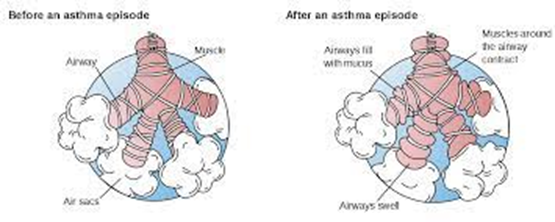A nurse is caring for a client with asthma. Which of the following happens physiologically when bronchospasm occurs?
Decreased mucus production contributes to airway constriction.
Inflammation is reduced due to airway diameter.
Bronchospasm occurs when there is Inflammation, edema, and excess mucus.
Airway obstruction occurs due to thinning mucus.
The Correct Answer is C
Choice A Reason:
Decreased mucus production contributes to airway constriction: This statement is incorrect. Bronchospasm does not decrease mucus production; instead, it primarily affects the smooth muscles surrounding the bronchioles, leading to their constriction and narrowing of the airways. Increased mucus production, often accompanied by inflammation, can contribute to airway obstruction in conditions like asthma.
Choice B Reason:
Inflammation is reduced due to airway diameter: This statement is incorrect. Bronchospasm typically occurs in the setting of inflammation in conditions such as asthma. Constriction of the airways during bronchospasm exacerbates the inflammation and can further narrow the airways, leading to symptoms such as wheezing and dyspnea.
Choice C Reason:
Bronchospasm occurs when there is inflammation, edema, and excess mucus: This statement is partially correct. Bronchospasm often occurs in the presence of inflammation, edema, and excess mucus production, as seen in conditions like asthma. These factors contribute to airway hyperresponsiveness, leading to bronchospasm and airway narrowing.
Choice D Reason:
Airway obstruction occurs due to thinning mucus: This statement is incorrect. Airway obstruction in conditions like asthma is primarily due to bronchospasm, inflammation, and excessive mucus production, rather than thinning mucus. Thinning of mucus would not typically contribute to airway obstruction.

Nursing Test Bank
Naxlex Comprehensive Predictor Exams
Related Questions
Correct Answer is ["B","D","E","F"]
Explanation
Choice A Reason:
Sedatives do not impact the risk of obstructive sleep apnea: This statement is incorrect. Sedatives, particularly those that cause muscle relaxation or depress the central nervous system, can exacerbate obstructive sleep apnea by further relaxing the muscles of the upper airway, leading to increased airway collapse during sleep.
Choice B Reason:
CPAP compliance enhances quality of sleep is correct. Continuous positive airway pressure (CPAP) therapy is a common treatment for obstructive sleep apnea. Compliance with CPAP therapy, meaning consistent and proper use of the CPAP device during sleep, is essential for effectively managing sleep apnea and improving sleep quality.
Choice C Reason:
Alcohol does not affect the risk of obstructive sleep apnea. This statement is incorrect. Alcohol consumption can worsen obstructive sleep apnea by promoting muscle relaxation in the upper airway, leading to increased airway collapse and more frequent episodes of apnea during sleep.
Choice D Reason:
Obesity increases the risk of obstructive sleep apnea. This statement is correct. Obesity is a significant risk factor for obstructive sleep apnea. Excess fat tissue around the neck can increase the likelihood of airway obstruction during sleep, contributing to the development or worsening of sleep apnea.
Choice E Reason:
Positional therapy enhances client comfort is correct. Positional therapy involves strategies to encourage sleeping in positions that minimize the severity of obstructive sleep apnea, particularly for individuals with positional OSA (where apnea events are primarily or significantly worse when sleeping in specific positions, such as supine). This statement is correct.
Choice F Reason:
Smoking increases the risk of obstructive sleep apnea: This statement is correct. Smoking can increase the risk of obstructive sleep apnea due to its effects on upper airway inflammation and respiratory function. Smoking cessation can be beneficial in managing sleep apnea and improving overall health.
Correct Answer is ["A","B","D"]
Explanation
Choice A Reason:
Genetics is correct. There is evidence to suggest that genetics play a role in the development of multiple sclerosis. Although no single gene has been identified as the cause of MS, certain genetic variations have been associated with an increased risk of developing the disease. Having a first-degree relative with MS increases an individual's risk, although the overall genetic contribution to MS susceptibility is thought to be relatively modest.
Choice B Reason:
Environmental factors is correct. Environmental factors are believed to play a significant role in the development of multiple sclerosis, particularly in individuals with a genetic predisposition. Factors such as vitamin D deficiency, smoking, exposure to certain infections (such as Epstein-Barr virus), and geographic location (latitude) have been implicated as potential triggers for MS development.
Choice C Reason:
Upper respiratory infections is incorrect. While infections may trigger exacerbations or relapses in individuals with existing multiple sclerosis, there is limited evidence to suggest that upper respiratory infections contribute directly to the development of MS. However, some research suggests that viral infections, particularly those occurring during childhood or adolescence, may influence the risk of developing MS later in life.
Choice D Reason:
Autoimmune factors is correct. Multiple sclerosis is widely recognized as an autoimmune disease, characterized by immune-mediated inflammation and damage to the central nervous system. In MS, the immune system mistakenly attacks myelin, the protective covering of nerve fibers, leading to demyelination and neurological dysfunction. Autoimmune factors are therefore considered central to the pathogenesis of MS.
Choice E Reason:
Urinary tract infections is incorrect. While urinary tract infections (UTIs) are common in individuals with multiple sclerosis due to bladder dysfunction associated with the disease, there is no direct evidence to suggest that UTIs contribute to the development of MS.
Whether you are a student looking to ace your exams or a practicing nurse seeking to enhance your expertise , our nursing education contents will empower you with the confidence and competence to make a difference in the lives of patients and become a respected leader in the healthcare field.
Visit Naxlex, invest in your future and unlock endless possibilities with our unparalleled nursing education contents today
Report Wrong Answer on the Current Question
Do you disagree with the answer? If yes, what is your expected answer? Explain.
Kindly be descriptive with the issue you are facing.
